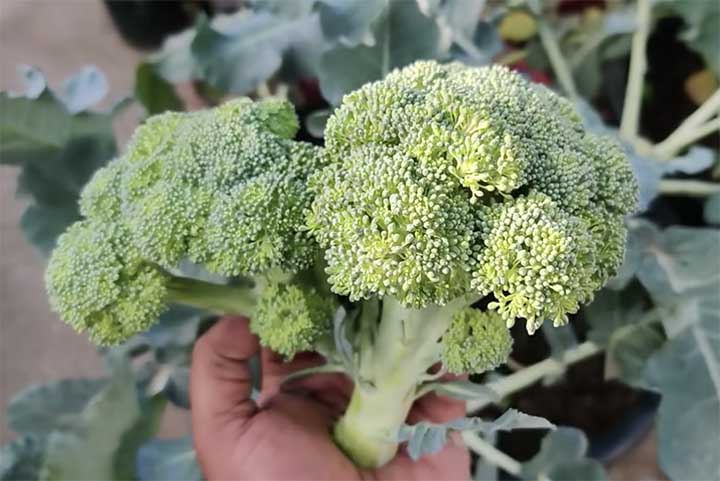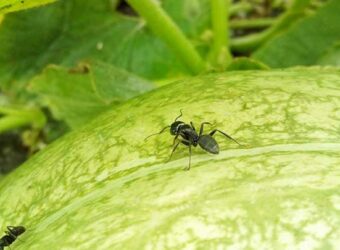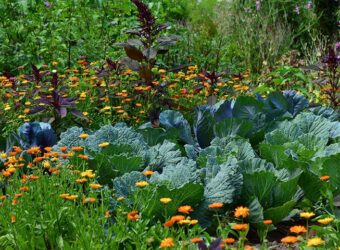When you think of plants that go well with broccoli, your mind may jump straight to the kitchen.
Maybe you think of combining pungent garlic and stir-fried broccoli to form a crunchy and bright dish. Or perhaps you imagine pairing broccoli florets with another classic cruciferous vegetable: cauliflower.
But what about when it comes to growing broccoli outdoors? Have you thought about what plants pair best with this beloved brassica?
If not, you should.
Companion planting, the act of planting multiple types of plants together to take advantage of benefits, can help your broccoli plants thrive. We’ll cover the benefits of using companion plants with broccoli and also list some of the best and worst broccoli companion plants.
The Benefits of Companion Plants for Broccoli
As mentioned above, companion planting is the act of using one type of plant to benefit another type of plant. In the best situations, the two plants develop a symbiotic relationship. This article explained everything about companion planting.
But what about broccoli? Why should you utilize companion planting when it comes to growing broccoli plants?
All sorts of reasons! We’ve outlined some of the benefits of planting broccoli companion plants below.
Control Common Pests
If you’ve grown broccoli before, you probably know that many pests love it.
Caterpillars such as cabbage loopers, armyworms, and cabbage moths munch on the plants’ leaves, quickly devouring seedlings and weakening mature plants. They can also feed on broccoli heads which makes them unsightly if not inedible.
Other common broccoli pests include small sap-sucking pests like aphids, spider mites, and thrips. These little guys can drink up plant sap and cause the plants to suffer.
While a few of these pests won’t do much damage, large numbers can severely weaken plants and even kill them. And since these little pests rapidly multiply, controlling them as soon as they appear is essential to keeping your broccoli healthy.
So, what does companion planting have to do with pest control? Biological pest control!
Your garden may contain “bad” bugs, but it can also contain “good” bugs aka beneficial insects. These insects feed on pests and help keep pest populations low.
Some common predatory insects include green lacewings, lady beetles, parasitoid wasps, and hoverflies.
If you want to attract these good bugs to your garden, you’ll need to supply them with the food and habitats they need to thrive during the various stages of their lives. While the larvae of these insects feed on pests, the adults often feed on nectar and/or pollen.
Therefore, adding flowering plants to your garden can help attract these good bugs and keep them around. And that means healthier broccoli plants!
Enrich the Soil
Broccoli plants, like most brassicas, require a lot of nutrients. If they don’t receive the nutrients they need, they may become stunted, diseased, or fail to produce broccoli heads.
One nutrient broccoli needs a lot of is nitrogen. This macronutrient is an essential component of proteins and helps with both vegetative growth and the formation of broccoli heads. If broccoli plants don’t receive enough nitrogen, the plants are likely to produce small broccoli heads.
Adding nitrogen-rich fertilizer to the soil is one way to provide your broccoli plant with this element. However, it’s not the only way!
Leguminous plants including beans, peas, clover, and vetch work to “fix” nitrogen from the air and turn it into a plant-available form. In technical speak, they convert nitrogen gas (N²) into ammonia (NH₃).
The plants don’t convert the nitrogen themselves. Instead, this conversion happens by rhizobia bacteria that live in nodules in the plants’ roots.
The bacteria provide the plants with nitrogen, and the plants provide the bacteria with carbohydrates. The result is a win-win!
So, how’s this benefit broccoli?
Oftentimes, the rhizobia bacteria produce more ammonia than the legumes can take up. The extra plant-available nitrogen is released into the soil, where plants like broccoli can take it up.
Best Companion Plants for Broccoli
1. Crimson Clover
Since broccoli is a cool-weather crop, it’s best to plant it in the early spring or late summer.
Spring planting allows young plants to grow up in cool temperatures but brings the risk of plants bolting in hot weather or being devoured by cabbage worms, harlequin bugs, and/or flea beetles that arrive in late spring/early summer.
Planting broccoli in the late summer means you’ll need to be diligent in protecting young plants from the hot summer sun. However, it also means that the plants get to mature in delightfully cool weather—which is one of the main reasons I prefer fall broccoli.
But the other reason is that I can grow broccoli and also plant crimson clover to protect winter soil that would otherwise be bare.
Crimson clover is a legume, which means it fixes nitrogen from the air and converts it into a form of nitrogen that plants can take up. And this is great news for nitrogen-hungry broccoli.
Proper timing is key when it comes time to plant the broccoli and clover together. The goal is to allow the broccoli plants to grow large enough that they don’t become shaded out by the clover but not wait so long that it’s too late in the year for the clover to become well-established.
I suggest you transplant broccoli plants, let them grow for two weeks, and then scatter clover seeds in the area around the base of the plant. You should aim for a seeding rate of about one pound of seed per 1000 square feet or around 100 seeds per square foot.
2. Sweet Alyssum
While humans are typically after broccoli heads, many pests love the plant’s leafy greens. One way to keep these pests at bay is by encouraging natural predators like lady beetles, green lacewings, parasitic wasps, and assassin bugs.
And one way to encourage these insects to stick around your garden is by planting flowering plants like sweet alyssum.
Sweet alyssum, sometimes simply known as alyssum, produces many tiny nectar-rich flowers. The flowers’ small size means that they are great food sources for tiny insects like parasitic wasps and hoverflies.
While adult parasitic wasps and hoverflies love to sip up sweet alyssum nectar, the larvae of some types of these insects voraciously feed on aphids, which are common broccoli pests.
Therefore, planting sweet alyssum with broccoli can encourage the presence of these beneficial insects and help keep your broccoli plants aphid-free.
3. Calendula
If you’re looking for another flowering plant that can grow well alongside broccoli, check out calendula. These plants produce lots of daisy-like blooms that are both edible and medicinal.
Since calendula plants produce a continuous supply of flowers over multiple weeks, or even months, they are a great food source for beneficial insects like adult green lacewings, parasitic wasps, and hoverflies.
When you support these adult forms of these insects, you encourage them to stick around the garden. And this is great news because the larvae forms of these insects feed on common broccoli pests like aphids, cabbage loopers, and thrips.
4. Dill
Dill is another plant that can help support beneficial insects. While you may know it for its fragrant fronds, dill plants can also produce oodles of umbel-shaped flowers.
Each of these “flowers” actually contains hundreds of tiny true flowers, all of which serve as nectar sources for tiny insects like hoverflies, parasitic wasps, and tachinid flies. While dill flowers can attract the adult forms of these insects to your garden, the big benefit is the larvae.
The larval forms of most of these insects feed on common broccoli pests including aphids, thrips, and spider mites. When these larvae are in your garden, your broccoli plants are more likely to remain healthy and pest-free.
5. Beets
Broccoli is known for being quite the heavy feeder. That means that it requires a large dose of nutrients to produce healthy green leaves and large broccoli heads.
Calcium is one of the nutrients that broccoli readily eats up—that explains why broccoli is a great source of calcium. This crucial nutrient helps plants form cell walls and cell membranes as well as transport messages within the plant.
If broccoli plants don’t have access to enough calcium, they may become stunted or develop brown leaf tips.
While all plants require some calcium to thrive, not all of them need as much calcium as broccoli plants do. Beets don’t need much calcium, which is one reason why they are a great companion plant for broccoli.
Beets also grow well in the type of cooler weather that broccoli loves, which makes these two plants a natural pairing.
6. Nasturtium
Another flowering plant that works well with broccoli is the nasturtium! This plant is often grown for its edible flowers and leaves that pack a peppery punch.
These plants can grow in both a trailing and bush form, so you’ll want to check what variety you’re growing before you add the plants to your garden. I think the bush-type nasturtiums work better with broccoli because you don’t have to worry about them overtaking the brassicas.
When it comes to the benefits of planting nasturtiums with broccoli, some research suggests that these plants can help with pest control. Broccoli plants that were interplanted with nasturtium had fewer cabbage loopers than a patch of just broccoli plants.
7. Onions
Both onions and broccoli perform well when planted in the early spring, which is one reason they’re a natural pairing. Plus, the same Iowa study referenced above suggests that onions can also help deter cabbage loopers.
When you plant these two crops together, be aware of their growth rates, mature size, and sunlight needs.
Broccoli plants grow quicker than onion plants and also put on a good amount of foliage. That means they can easily shade out the onions if you’re not careful.
Rather than planting broccoli and onions directly together, you can plant a block of onions next to a broccoli patch. If you do choose to plant the two in the same garden bed, plant the onions about 18 inches away from the broccoli plants.
Along with planting bulbing onions, you can experiment with planting green onions. These bunching onions mature more quickly than bulbing onions.
8. Thyme
If you’re looking for a way to keep out pesky broccoli pests like cabbage loopers and cabbage worms, thyme might be your best bet! One trial showed that broccoli planted with thyme had no signs of insect damage!
This means that thyme might offer better pest control than popular companion plants like onions and marigolds. But remember that increased plant diversity is typically good, so you can plant broccoli with more than one type of companion plant.\
Another benefit of thyme is its tiny flowers. These little blooms provide a food source for beneficial insects such as hoverflies and parasitic wasps.
Since thyme is a perennial plant, you’ll need to think carefully about where you plant it in your garden. While you can move the plants once they’re established, it’s generally better to leave them in the same spot for multiple years.
If you want to move thyme plants around your garden, try planting them in pots. This will also allow you to move the plant indoors during the winter.
There are also multiple types of thyme, you can experiment with planting varieties like lemon thyme, English thyme, and French thyme.
9. Lettuce
Since lettuce has a shallow root system and broccoli’s roots run deep, these two crops can work well together.
Tucking lettuce on the east side of the broccoli plants is often a great choice since it will allow the broccoli plants to provide the lettuce with afternoon shade.
Both head lettuce and baby leaf lettuce can work well as broccoli companion plants.
10. Radishes
While some people think that planting two members of the brassica family together is a bad idea, I tend to disagree. Since broccoli and radishes are in the same plant family, they have similar nutrient needs and are susceptible to the same pests.
This means that you can prepare your soil in a way that will support both crops and also watch out for the same pests in one area.
I love growing radishes amongst broccoli due to the plants’ different growth rates. While broccoli typically takes about two months to mature, small radishes are ready in one month.
That means you can plant radishes about 6–12 inches away from broccoli plants. By the time the broccoli plants begin to crowd out the radishes, the roots will be ready to harvest.
Worst Companion Plants for Broccoli
Try to avoid planting these crops right by your broccoli plants. While they won’t necessarily lead to broccoli’s demise, they are the best pals for this cole crop.
1. Basil
While some people report that fragrant basil is a good companion for broccoli, the research says otherwise.
The companion planting study conducted in Iowa reported that broccoli interplanted with basil had more cabbage worms than the planting of just broccoli. That suggests basil attracts these pests.
Basil also thrives in the heat, while broccoli prefers cooler weather. So if you’re growing them simultaneously, one of the plants is likely unhappy.
2. Squash
Neither winter squash like butternut and acorn squash nor summer squash like crookneck squash and zucchini are good companion plants for broccoli. Both squash and broccoli take up a lot of space, so they quickly choke each other out.
Squash also prefers warm weather, while broccoli thrives in cooler temperatures.
3. Tomatoes
Both tomatoes and broccoli require a high amount of nutrients to thrive. That means that planting them together can lead to depleted soils and/or weak plants.
Similarly, both of these plants take up a lot of space. If you end up planting tomatoes and broccoli next to each other, you’ll need to allow at least two feet between the plants.
Finally, tomatoes and broccoli thrive in different seasons. While tomatoes love the long, hot days of summer, broccoli plants grow best in the cool spring or fall.
4. Peppers
Peppers are another heat-loving crop. Therefore, they are not typically grown in the same season as broccoli.
Broccoli and peppers are also large crops that typically grow about two feet in diameter. Therefore, these two are the best match.
5. Corn
While broccoli likes cool weather, it also requires full sun to thrive. Corn will shade broccoli plants, which may cause them to become stunted.
Corn also thrives in the summer, while broccoli grows best in the spring and fall. Therefore, temperature requirements alone suggest that these crops are poor companions.






